Koji Sato is the current President and CEO of Toyota Motor Corporation. He took over the role in April 2023, succeeding Akio Toyoda. Before becoming president, Sato had a distinguished career at Toyota, where he held various leadership roles. Notably, he was the head of the Lexus brand starting in 2016, and later became Chief Branding Officer in 2021.
Sato joined Toyota in 1992 and has been instrumental in driving the company’s strategic direction, particularly in areas related to innovation, electric vehicles, and brand development. As president, his leadership focuses on strengthening Toyota’s position in the evolving automotive industry, embracing new technologies, and expanding the company’s global presence.













































